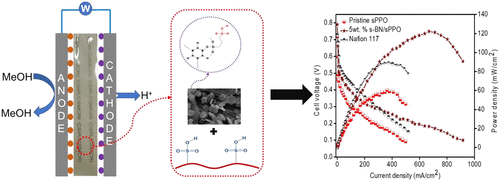当前位置:
X-MOL 学术
›
ACS Appl. Energy Mater.
›
论文详情
Our official English website, www.x-mol.net, welcomes your
feedback! (Note: you will need to create a separate account there.)
Insight toward the Electrochemical Properties of Sulfonated Poly(2,6-dimethyl-1,4-phenylene oxide) via Impregnating Functionalized Boron Nitride: Alternate Composite Polymer Electrolyte for Direct Methanol Fuel Cell
ACS Applied Energy Materials ( IF 5.4 ) Pub Date : 2020-06-22 00:00:00 , DOI: 10.1021/acsaem.0c01128 Vikrant Yadav 1, 2 , Nagaraju Niluroutu 3 , Santoshkumar D. Bhat 2, 3 , Vaibhav Kulshrestha 1, 2
ACS Applied Energy Materials ( IF 5.4 ) Pub Date : 2020-06-22 00:00:00 , DOI: 10.1021/acsaem.0c01128 Vikrant Yadav 1, 2 , Nagaraju Niluroutu 3 , Santoshkumar D. Bhat 2, 3 , Vaibhav Kulshrestha 1, 2
Affiliation

|
A series of polymer electrolytes of sulfonated poly(2,6-dimethyl-1,4-phenylene oxide) (sPPO) in combination with two-dimensional sulfonated boron nitride (s-BN) has been synthesized to form composite polymer electrolytes for direct methanol fuel cell (DMFC). The sulfonation of boron nitride (BN) has been confirmed by XPS, FT-IR, and elemental analysis. The composite membranes have been characterized for their water content, ion transport phenomenon, and thermo-mechanical stabilities along with methanol crossover resistance. Further, s-BN shows good dispersion in sPPO composite membranes by forming amplified long-range ionic clusters via hydrophilic or hydrogen bonding interaction between the s-BN and sPPO matrix. The optimized s-BN/sPPO (5 wt %) composite membrane reveals 67% higher proton conductivity and one-third methanol permeability compared to pristine sPPO membrane. The s-BN/sPPO (5 wt %) composite membrane presents a DMFC peak power density of 122 mW/cm2, which is higher than the peak power densities of 88 and 60 mW/cm2 for Nafion 117 and pristine sPPO, respectively. The preferential increase in electrochemical selectivity of composite membranes suggests their potential in DMFCs.
中文翻译:

通过浸渍功能化氮化硼对磺化聚(2,6-二甲基-1,4-苯撑氧)的电化学性能的了解:直接甲醇燃料电池的替代复合聚合物电解质
合成了一系列磺化聚(2,6-二甲基-1,4-苯撑氧)(sPPO)与二维磺化氮化硼(s-BN)的聚合物电解质,以形成直接甲醇的复合聚合物电解质燃料电池(DMFC)。XPS,FT-IR和元素分析已证实氮化硼(BN)的磺化。复合膜的特征在于其水含量,离子迁移现象,热机械稳定性以及耐甲醇穿越性。此外,s-BN通过s-BN与sPPO基质之间的亲水或氢键相互作用形成放大的长距离离子簇,从而在sPPO复合膜中显示出良好的分散性。与原始的sPPO膜相比,优化的s-BN / sPPO(5 wt%)复合膜显示出高67%的质子传导率和三分之一的甲醇渗透率。s-BN / sPPO(5 wt%)复合膜的DMFC峰值功率密度为122 mW / cm2的峰值功率密度分别高于Nafion 117和原始sPPO的峰值功率密度88和60 mW / cm 2。复合膜电化学选择性的优先增加表明它们在DMFC中的潜力。
更新日期:2020-06-22
中文翻译:

通过浸渍功能化氮化硼对磺化聚(2,6-二甲基-1,4-苯撑氧)的电化学性能的了解:直接甲醇燃料电池的替代复合聚合物电解质
合成了一系列磺化聚(2,6-二甲基-1,4-苯撑氧)(sPPO)与二维磺化氮化硼(s-BN)的聚合物电解质,以形成直接甲醇的复合聚合物电解质燃料电池(DMFC)。XPS,FT-IR和元素分析已证实氮化硼(BN)的磺化。复合膜的特征在于其水含量,离子迁移现象,热机械稳定性以及耐甲醇穿越性。此外,s-BN通过s-BN与sPPO基质之间的亲水或氢键相互作用形成放大的长距离离子簇,从而在sPPO复合膜中显示出良好的分散性。与原始的sPPO膜相比,优化的s-BN / sPPO(5 wt%)复合膜显示出高67%的质子传导率和三分之一的甲醇渗透率。s-BN / sPPO(5 wt%)复合膜的DMFC峰值功率密度为122 mW / cm2的峰值功率密度分别高于Nafion 117和原始sPPO的峰值功率密度88和60 mW / cm 2。复合膜电化学选择性的优先增加表明它们在DMFC中的潜力。











































 京公网安备 11010802027423号
京公网安备 11010802027423号